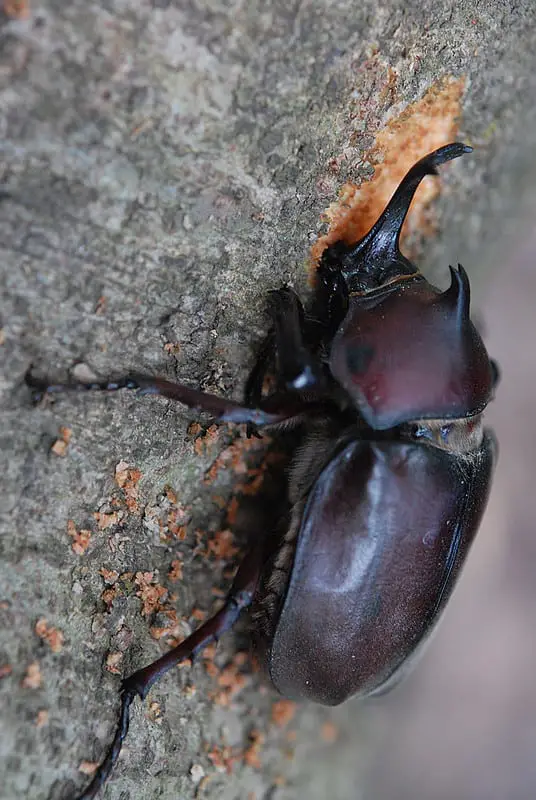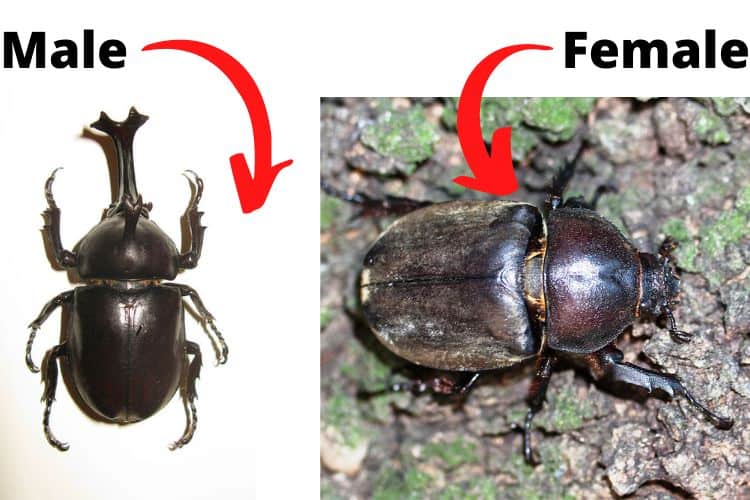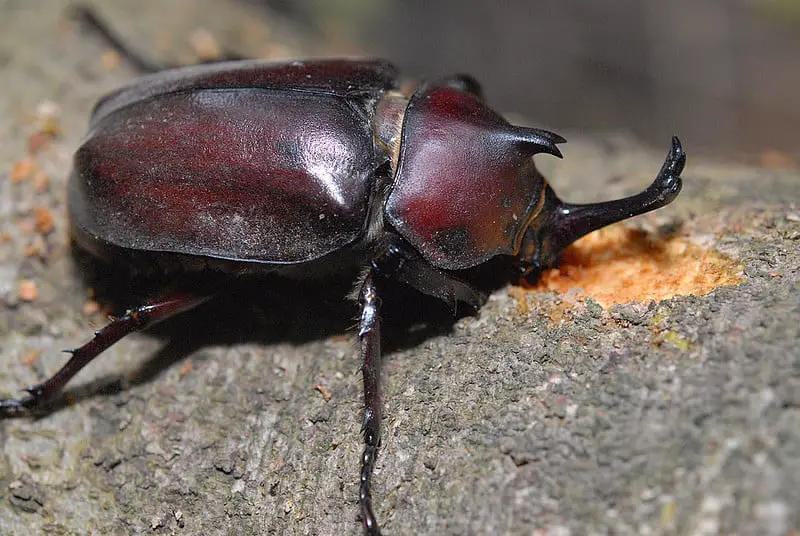The Japanese Rhinoceros Beetle is a powerful and fiery insect. Able to catapult their rivals using their horns, these insects are amazingly strong animals. Popular in the Japanese culture, JRBs can be found in every pet store, where they make great choices for kids.
Children in Japan love to play with these amazing insects in the forest, where it’s not hard to find them. They’re also rapidly becoming popular in the west, so if you’re interested in getting one of these exotic insects as a pet, you’ve come to the right place. We’ve gathered all the information you need to properly care for these marvelous creatures.

Japanese Rhinoceros Beetle Care Sheet
| Name of species | Allomyrina dichotoma |
| Family | Scarabaeidae |
| Common name | Japanese Rhinoceros Beetle |
| Category | Beetle |
| Type | Rhinoceros Beetle |
| Native location | Japan, Taiwan, Korea |
| Size | 3 inches |
| Diet | Fruit, tree saps, decaying bark |
| Lifespan | 16 months |
| Experience level | Beginner |
Rhinoceros Beetle Overview
The Allomyrina dichotoma is popularly known as the Japanese Rhinoceros Beetle. It’s also called Japanese Stag Beetle, Japanese Horned Beetle, and “kabutomushi” particularly in Japan.
They’re mostly found in oak trees in Japan, where they feed on sap and suit fruits they find.
These insects spend most of their short lives underground, living only four months out in the open as full-grown beetles.
Appearance & Varieties

Rhinoceros beetles are large beetles with strong carapaces and long horns. The JRB isn’t an exception, with one long horn that splits into two points at the center of its head and a smaller horn curved over it.
This is the appearance of males, as JRBs display dimorphism, and females don’t have the characteristic horns.
The kabutomushis have two main colors, dark brown and reddish-brown, but it’s not uncommon to see them with middle tones of that color palette.
Price
Japanese Rhinoceros Beetles are very common, widespread, and not hard to breed. They’re also very easy to find in the wild since kids from Japan, Korea, Taiwan, and Western China will find plenty of them in a forest if they know where to look.
Because of their abundance, they’re very cheap to buy. Females can be found for around $5, while males range from $7 to $15, depending on where you get them.
Behavior and Temperament
As most rhinoceros beetles do, the Japanese Rhinoceros Beetle practices a mating ritual consisting of jousting with its horns. The winner hopes to attract the attention of females, so it’s a bad idea to place male specimens in the same enclosure unless you want them to fight each other.
Besides jousting, JRBs are peaceful beetles that represent no harm to humans. They’re most active during the night, and they spend most of their lives underground until they reach adulthood, when they only burrow during the day.
If you’re interested in a beetle you can handle, the JRB is a great choice. It isn’t venomous, and even though they have mouths, they don’t bite humans.
The only thing you should be careful with is when they get a strong hold of your hand or any other surface. In these cases, you should push them gently forward to a new surface instead of pulling them, so they don’t hurt their legs.
Caring for a Japanese Rhinoceros Beetle

Temperature and Humidity
The Japanese Rhinoceros Beetles live in tropical and subtropical climates with high humidity. Temperatures go from 44°F in cold zones to 73°F in warmer locations, and the humidity is as high as 77% to 88%.
You should keep them in temperatures from 50°F to 70°F, but it’s even more important to maintain high humidity ranging between 75% and 85%.
It’s not uncommon to use humidifiers to reach these conditions, which are very important for the JRB since dry weather may be lethal for them.
With such high humidity, ventilation is also important.
Substrate
The Japanese Rhinoceros Beetle needs a soft substrate that’s efficient at moisture retention. This is the kind of soil it’s used to in the wild, so mixtures with peat moss will suit it best.
As for the depth, two to three inches of substrate should be enough for these burrower beetles; however, if the population inside a closure increases, the substrate may need to grow as well.
Japanese Rhinoceros Beetles are known to have mites in them. It’s an obnoxious problem that can be controlled by mixing charcoal in the substrate. Japanese pet stores sell these charcoal mixes, so it’s a well-known solution to control the mites.
Tank
The Japanese Rhinoceros Beetle feels comfortable in decorated medium-sized enclosures. Decaying leaves, bark, and branches are great ways to make the tank more comfortable for it.
Also, if you add small plants, it makes it easier for the soil to retain moisture, which is ideal for these tropical insects.
Watering
Japanese stores sell a special beetle humidifier or water bottle that regularly sprays the enclosure’s soil. However, it’s no problem if you don’t have access to one of these; you can spray the enclosure with water twice a week; just avoid pouring water directly over the beetles.
Water dishes aren’t necessary, but you may place one inside the enclosure if you want to be sure. This water dish shouldn’t be too deep to keep the JRB from falling inside and drowning.
Diet of a Japanese Rhinoceros Beetle
The Japanese Rhinoceros Beetle enjoys eating sweet meals. Tree sap, sweet fruits, and beetle jelly are great for them.
It is particularly ideal to feed them with beetle jelly since it has special nutrients that will make your insect more healthy; however, pieces of bananas and watermelons are also popular choices among keepers.
These nocturnal animals will feed during the night, so you should give them a piece of food each night and pick up whatever’s left the following morning to prevent the enclosure from forming mold and fungus.
Fun Facts about the Japanese Rhinoceros Beetle
- The larvae of the JRB have ethnopharmacological uses. They’re used to treat digestive disorders in Japan and China. It’s also approved for human consumption, thanks to its high nutrients.
- The Allomyrina dichotoma is called “kabutomushi” in Japanese, which can be translated as “helmet bug.” The JRB’s particular head and horns can be perceived as a helmet, specifically the ones used by Japanese samurai warriors since they also used to have large horns.
- The kabutomushi is very important to Japan’s culture. It’s relevant and influential in many cultural productions such as TV shows and children’s stories.
- Most people are aware that male JRBs fight with each other over the possibility of attracting a female JRB. However, it was recently discovered that this wasn’t the end of the mating ritual for Japanese Rhinoceros Beetles. After the fight is over, the winner beetle sings a serenade to the female JRB. The mating occurs if she decides to accept the male’s advances; however, female JRBs can reject males even after the serenade.
Final words: Is the Japanese Rhinoceros Beetle right for you?
Getting a couple of Japanese Rhinoceros Beetles and starting your own home lineage of insect warriors is an appealing idea for most hobbyists.
They’re easy to get, care for, and they’re also amazing to watch.
On the whole, these beginner-friendly beetles are a great choice for insect keepers at any experience level and you can’t go wrong by picking one up!
If you don’t think this beetle is for you, try checking out the Atlas Beetle instead!
- How Long Do American Eskimo Dogs Live? Important Factors and Care Tips - September 29, 2023
- Do American Bulldogs Need Grooming? Essential Tips and Care Guidelines - September 29, 2023
- Do Bengal Cats Enjoy Playing? Essential Tips for Keeping Them Active - September 29, 2023